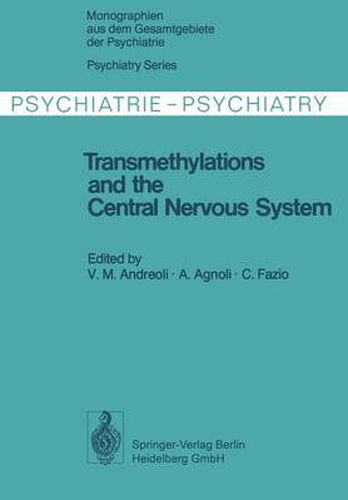Readings Newsletter
Become a Readings Member to make your shopping experience even easier.
Sign in or sign up for free!
You’re not far away from qualifying for FREE standard shipping within Australia
You’ve qualified for FREE standard shipping within Australia
The cart is loading…






This title is printed to order. This book may have been self-published. If so, we cannot guarantee the quality of the content. In the main most books will have gone through the editing process however some may not. We therefore suggest that you be aware of this before ordering this book. If in doubt check either the author or publisher’s details as we are unable to accept any returns unless they are faulty. Please contact us if you have any questions.
V M. ANDREOLl, A. AGNOLI, and C. FAZIO The transfer of a methyl group from a donor to an acceptor compound is a fundamental biochemie al process long since known to biologists; the process is involved, for instance, in the metabolism of porphyrins, nuc1eic acids, and fatty acids. Only recently, however, did transmethylation processes reveal their decisive role in CNS biochemistry - namely with the discovery that such processes are linked with the biogenie amines that have been conc1usively identified as the chemical mediators of neu- ronal transmission and, more broadly, of behavior. The first suggestion that transmethylation processes might be involved in the origina- tion of certain mental diseases came from Harley-Mason (1952), who noticed that many of the hallucinogenic substances known at that time contained methyl radicals, and par- ticularly that mescaline represented the product of O-methylation of dopamine in posi- tions 3, 4, and 5. This hypothesis was put forward when the O-methylation of catechol- amines by catechol-O-methyltransferases had not yet been described. Harley-Mason further proposed that in the living organism the process of O-methyla- tion might follow a deviant metabolie pathway, and that the accumulation of abnor- mal methylated metabolites endowed with hallucinogenic properties might be responsi- ble for the implementation of some mental diseases, notably schizophrenia. He also called attention to a substance, 3,4-dimethoxyphenylethylamine (3,4-DMPEA) as a possible psychotogenic moleeule, on the strength of its capacity for producing cata- tonia in experimental animals.
$9.00 standard shipping within Australia
FREE standard shipping within Australia for orders over $100.00
Express & International shipping calculated at checkout
This title is printed to order. This book may have been self-published. If so, we cannot guarantee the quality of the content. In the main most books will have gone through the editing process however some may not. We therefore suggest that you be aware of this before ordering this book. If in doubt check either the author or publisher’s details as we are unable to accept any returns unless they are faulty. Please contact us if you have any questions.
V M. ANDREOLl, A. AGNOLI, and C. FAZIO The transfer of a methyl group from a donor to an acceptor compound is a fundamental biochemie al process long since known to biologists; the process is involved, for instance, in the metabolism of porphyrins, nuc1eic acids, and fatty acids. Only recently, however, did transmethylation processes reveal their decisive role in CNS biochemistry - namely with the discovery that such processes are linked with the biogenie amines that have been conc1usively identified as the chemical mediators of neu- ronal transmission and, more broadly, of behavior. The first suggestion that transmethylation processes might be involved in the origina- tion of certain mental diseases came from Harley-Mason (1952), who noticed that many of the hallucinogenic substances known at that time contained methyl radicals, and par- ticularly that mescaline represented the product of O-methylation of dopamine in posi- tions 3, 4, and 5. This hypothesis was put forward when the O-methylation of catechol- amines by catechol-O-methyltransferases had not yet been described. Harley-Mason further proposed that in the living organism the process of O-methyla- tion might follow a deviant metabolie pathway, and that the accumulation of abnor- mal methylated metabolites endowed with hallucinogenic properties might be responsi- ble for the implementation of some mental diseases, notably schizophrenia. He also called attention to a substance, 3,4-dimethoxyphenylethylamine (3,4-DMPEA) as a possible psychotogenic moleeule, on the strength of its capacity for producing cata- tonia in experimental animals.